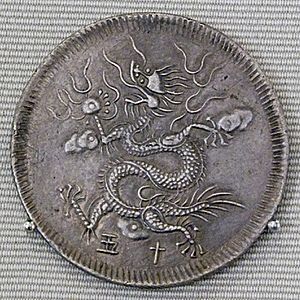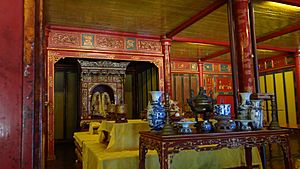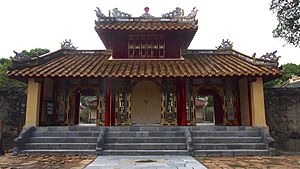Minh Mạng facts for kids
Quick facts for kids Emperor Minh Mạng明命帝 |
|||||||||||||||||
|---|---|---|---|---|---|---|---|---|---|---|---|---|---|---|---|---|---|
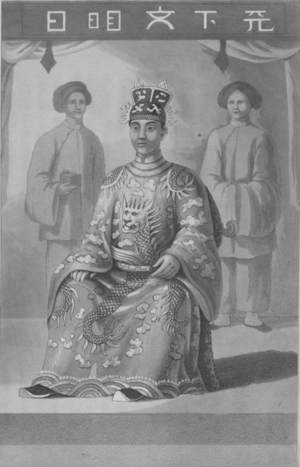
Portrait drawing
|
|||||||||||||||||
| Emperor of Việt Nam | |||||||||||||||||
| Reign | 14 February 1820 – 15 February 1839 | ||||||||||||||||
| Predecessor | Gia Long | ||||||||||||||||
| Successor | Việt Nam renamed to Đại Nam | ||||||||||||||||
| Emperor of Đại Nam | |||||||||||||||||
| Reign | 15 February 1839 – 20 January 1841 | ||||||||||||||||
| Predecessor | Việt Nam renamed to Đại Nam | ||||||||||||||||
| Successor | Thiệu Trị | ||||||||||||||||
| Emperor of the Nguyễn dynasty | |||||||||||||||||
| Reign | 14 February 1820 – 20 January 1841 | ||||||||||||||||
| Predecessor | Gia Long | ||||||||||||||||
| Successor | Thiệu Trị | ||||||||||||||||
| Born | 25 May 1791 Gia Định, Việt Nam |
||||||||||||||||
| Died | 20 January 1841 (aged 49) Imperial City, Huế |
||||||||||||||||
| Burial | 20 August 1841 - Hiếu Lăng, Imperial City, Huế | ||||||||||||||||
|
|||||||||||||||||
| House | Nguyễn Phúc | ||||||||||||||||
| Father | Gia Long | ||||||||||||||||
| Mother | Empress Thuận Thiên | ||||||||||||||||
| Religion | Confucianism | ||||||||||||||||
| Signature |  |
||||||||||||||||
Minh Mạng (born Nguyễn Phúc Đảm) was the second emperor of the Nguyễn dynasty in Vietnam. He ruled from February 14, 1820, until his death on January 20, 1841. He was the fourth son of Emperor Gia Long, who was the first emperor of the Nguyễn dynasty.
Minh Mạng is remembered for his strong opposition to French involvement in Vietnam. He also strictly followed Confucianism, a system of beliefs and values from ancient China.
Contents
Becoming Emperor: Minh Mạng's Early Life
Nguyễn Phúc Đảm, later known as Emperor Minh Mạng, was born in Gia Định (now part of Ho Chi Minh City) on May 25, 1791. His father was Nguyễn Phúc Ánh, who would become Emperor Gia Long. His mother was Trần Thị Đang, known as Empress Thuận Thiên.
When he was three years old, he was raised by Gia Long's first wife, Empress Thừa Thiên. Even though Thừa Thiên's grandson was expected to take over after her death, Gia Long chose Phúc Đảm as his heir in 1816. After this, Phúc Đảm began helping his father with government duties.
When Gia Long died, Minh Mạng faced challenges. One of the biggest came from Lê Văn Duyệt, a trusted general who had helped Gia Long win power. Duyệt was given a lot of freedom to rule the southern part of Vietnam.
Minh Mạng's Policies: Keeping Vietnam Independent
Controlling Christian Missionaries
Minh Mạng was worried about the spread of Christianity in Vietnam. In February 1825, he banned Christian missionaries from entering the country. He ordered ships to be searched carefully to prevent missionaries from sneaking in. He believed Christianity was a "perverse European" practice that could "corrupt the hearts of men."
He tried to stop missionaries by calling French priests to the capital, Huế, and giving them high-ranking government jobs. This was meant to keep them from preaching. However, some priests continued their missionary work, leading to arrests. After some time, Minh Mạng agreed to release the priests if they returned to France. But some disobeyed and continued preaching, leading to more arrests and executions.
-
Painting depicts the trial and execution of three Catholics in Ninh Bình.
Isolation: Vietnam's Foreign Policy
Minh Mạng continued his father's policy of keeping Vietnam isolated from Western countries. He wanted to avoid Western influence and ideas. In 1804, his father had already turned away a British group wanting to trade.
Minh Mạng also rejected trade agreements and alliances from other countries. For example, in 1819, an American naval officer named John White visited Vietnam. Minh Mạng was only willing to buy military supplies, but no major trade deal happened. He also turned away French and British trade offers.
This isolationist policy meant Vietnam fell behind in technology compared to European powers. As European countries became more stable, they started looking to expand their influence in Asia. Minh Mạng's strong opposition to Western ideas made Vietnam more vulnerable in the long run.
Changes at Home: Domestic Reforms and Challenges
Improving the Country's Administration
Minh Mạng worked to improve Vietnam's government and infrastructure. He oversaw the building of highways and a postal service. He also created public storage areas for food and made changes to money and farming systems.
He tried to prevent wealthy people from owning too much land by regularly redistributing it. In 1840, he even ordered rich landowners to give back a third of their land to the community. He also made the government more centralized and improved the system for choosing government officials.
Dealing with Diseases and Rebellions
Minh Mạng's reign faced many challenges, including diseases, natural disasters, and frequent rebellions. For example, a severe cholera pandemic in 1820 caused many deaths.
About 200 rebellions happened during his 20-year rule. These uprisings often came from people who were unhappy with their living conditions or felt oppressed.
Expanding the Empire and Cultural Policies
Minh Mạng wanted to expand Vietnam's territory and spread Vietnamese culture. He supported the king of Vientiane (in modern-day Laos) in a war against Siam (modern-day Thailand). After some conflicts, a part of Laos became a Vietnamese prefecture in 1832.
He also completed the conquest of the Champa Kingdom, which had been a long-standing conflict. Minh Mạng tried to make the Cham people and other highland groups adopt Vietnamese culture.
In 1834, he brought Cambodia under Vietnamese control, calling it Tây Thành province. He tried to make Cambodians dress and live like Vietnamese people. This led to many revolts in Cambodia, which were put down by Vietnamese forces.
Major Rebellions During His Reign
One of the most significant rebellions was the Lê Văn Khôi revolt, which started in July 1833. Lê Văn Khôi was the adopted son of the powerful general Lê Văn Duyệt. After Duyệt died, Minh Mạng ordered his grave to be punished, which angered many people in the south who respected Duyệt.
Khôi's rebels took control of southern Vietnam and even captured a French missionary, Joseph Marchand, hoping to gain Catholic support. They also got help from Siam. However, Minh Mạng's forces eventually defeated the Siamese and recaptured the south. Saigon fell in September 1835, and many rebels were executed. Missionaries were also rounded up, and some were put to death.
These rebellions and the policy of forcing non-Vietnamese groups to adopt Vietnamese culture led to more ethnic revolts in southern Vietnam from 1841 to 1845.
Minh Mạng's Leadership Style and Legacy
Minh Mạng was known for being a firm and scholarly ruler. He was interested in Western technologies like mechanics and weapons, even though he disagreed with European culture. He even arranged for a French surgeon to vaccinate his royal family against smallpox. He was also a poet and paid great attention to the details of running the country.
When Minh Mạng died, his son, Emperor Thiệu Trị, took the throne. Thiệu Trị was even stricter about Confucianism and against foreign influence. This led to more conflicts with European powers, especially France, which eventually led to Vietnam's colonization.
Despite the challenges, Minh Mạng made the government more efficient, stopped a Siamese invasion, and built many important monuments in the imperial city of Huế.
Minh Mạng's Family and Successors
Minh Mạng had a very large family, with 142 children from 43 wives. His sons included Miên Tông (who became Emperor Thiệu Trị), Miên Định, Miên Thẩm, and Miên Trinh. Three of his daughters, Nguyệt Đình, Mai Am, and Huệ Phố, were famous poets.
To avoid confusion among his many descendants, Minh Mạng created a special "Imperial succession poem" to name them. Each generation of boys would have a name starting with a specific word from the poem.
|
|
For example, his son Thiệu Trị's name started with "Miên." Thiệu Trị's son, Tự Đức, had a name starting with "Hường."
Girls also received different names based on their generation, such as Công-chúa or Tôn-nữ.
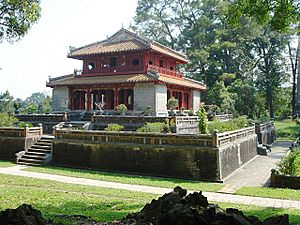
See also
 In Spanish: Minh Mạng para niños
In Spanish: Minh Mạng para niños








